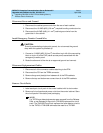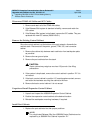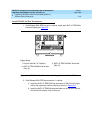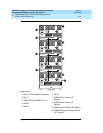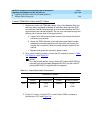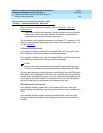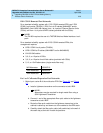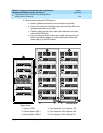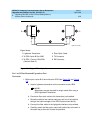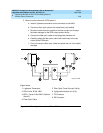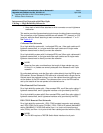
DEFINITY Enterprise Communications Server Release 8.2
Upgrades and Additions for R8r
555-233-115
Issue 1
April 2000
Upgrading R5si/R6si to R8r EPN and Adding Memory
3-22Release 5/6si to Release 8r
3
Interconnect Port Networks with Fiber Optic
Cabling — Standard Reliability Release 8r
After all fiber optic equipment is installed, refer to
Chapter A, ‘‘Fiber Link
Administration’’.
1. Keep track of which fiber attaches to which connector on each lightwave
transceiver. Label every cable installed. This section provides figures
showing typical examples of these connections.
The connectors on the lightwave transceivers are labeled “TX” (transmit) or “RX”
(receive), while the fibers attaching to each connector are numbered either “1” or
“2.” See
Figure 3-7
.
Collocated Port Networks
For a standard reliability system with 1 collocated EPN, use 1 fiber optic cable
and 2 lightwave transceivers to directly connect the networks.
For a standard reliability system with 2 collocated EPNs, use 3 fiber optic cables
and 6 lightwave transceivers to directly connect the networks.
NOTE:
Based on floor plan considerations, the length of these cables may vary.
20-foot (6.1 m) cables are normally adequate for a Release 8r with 2 PNs.
For collocated cabinets, route the fiber optic cables directly from the PPN to each
EPN cabinet. Since a Release 8r PPN cabinet is collocated with a Single-Carrier
Cabinet stack, the preferred routing is to run the cables
down
the cable tray and
out the bottom of the PPN cabinet. The cables are then run to the EPN cabinet
and up the outside of the rear panels to the desired carrier level.
Fiber Remoted Port Networks
For a standard reliability system with 1 fiber-remoted EPN, use 2 fiber optic
cables,2 lightwave transceivers, and 2 lightguide interface units (provided by the
PSC).
For a standard reliability system with 2 fiber-remoted EPNs, use 6 fiber optic
cables, 6 lightwave transceivers, and 6 lightguide interface units (provided by
the PSC).



